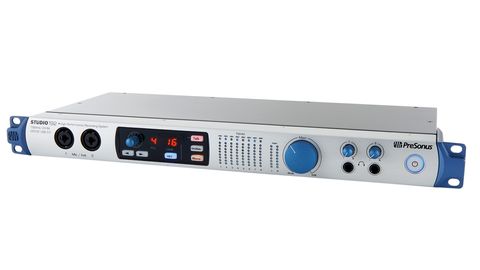PreSonus' Studio 192 audio interface is the latest in a new breed of device which substantially surpasses the initial remit of 'only' allowing you to record audio into your computer and to hear it back.
Its tag line is 'Studio Command Centre' and, while that might sound a little bit Star Trek, a quick tour of the Studio 192 gives justification to its lofty sub-labelling.
This is an interface offering 26 inputs and 32 outputs via its combined analogue and digital capabilities, at recording qualities of up to 24-bit resolution and 192kHz sample rate.
Onboard are eight remotely-controllable XMAX preamps, all of which are loaded with PreSonus' AI Fat Channel Processing, to allow you to enable effects capabilities for monitoring purposes while recording.
Both S/PDIF and ADAT connections push the analogue capabilities beyond into the digital domain, while connection to your computer is via USB 3.0 which promises transfer rates enabling zero-latency monitoring. And the entire package is squeezed into a single rack space.
The front panel of the interface provides access to the first two of the eight analogue inputs, all of which allow for XLR or 1/4-inch connections. To the right-hand side of a central LED display, you'll find ladder LEDs displaying input levels of the eight preamps, as well as output ladders for the stereo outputs.
Further to the right, are twin, independently configurable headphone amplifiers to which you can assign the monitor mixes of your choice. The central area allows you to configure the preamps from the hardware, with each channel selectable from the arrow buttons and the rotary above letting you set an appropriate level.
Phantom power can be switched on here too, while to the left, a Talkback button lets you communicate with performers via the built-in microphone. Suddenly, the Studio Command Centre tag starts to be justified.
Round the back, you'll find the remaining six preamps, alongside digital connections, with ADAT connectivity available via twin input and output ports.
Purchase of the Studio 192 provides access to two pieces of software which allow you to make greater use of the hardware.
Firstly, PreSonus' Studio One recording environment, now at version 3, provides a DAW complete with 3GB of free-to-download content to allow you to build new tracks, with the 192 interface fully configurable from within.
If, however, you're planning to use the 192 within your existing DAW, the second piece of software - Universal Control - will appeal even more. This provides access to the 192's settings, including the XMAX preamps and their associated Fat Channel processing capabilities.
These include dynamics and EQ processors for monitoring, to allow you to see configurations on a more holistic scale as you set up a session. You can go further by downloading the UC Surface Control software for your iPad, allowing performers to configure their own levels and headphone settings as they record.
Command central
With a broad selection of features, impressive flexibility and high-quality interfacing, the Studio 192 has an awful lot going for it. One cautionary note is that for now, the latest two versions of the Mac OS X software require connection via USB 2.0 rather than 3.0, though PreSonus stress that this doesn't affect performance.
To get the most out of the 192, you'll benefit from familiarising yourself with its software capabilities, as these streamline your work with the hardware. That said, the hardware is by no means rudderless without the software.
The preamps sound pleasingly musical yet transparent while, for those seeking even larger systems, compatibility with PreSonus' own DigiMax DP88 allows for a further boost to the I/O capabilities. Overall, this is an impressive contender which scores very highly when balancing quality against value for money.

